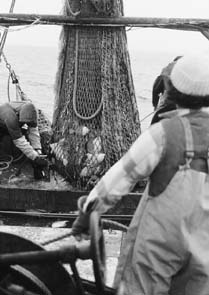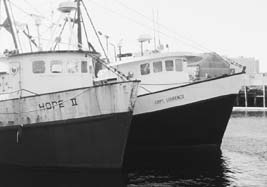
|
Archives:
Summer/Fall 2001 Table
of Contents In devising fisheries regulations, the National Marine Fisheries Service (NMFS) is required by law to try to minimize the impact of those regulations on fishing communities. Such consideration requires a definition of a fishing community and a compilation of social, cultural and economic data. However, in the quarter century since the Magnuson Act was first put into effect, regulators have rarely had access to this information, says Madeleine Hall-Arber, an anthropologist with MIT Sea Grant. "No long-term, consistent or comprehensive studies had been done, making consideration of the impacts of regulatory change almost impossible to analyze. In the last few years, people in fishing communities in Florida and Virginia started suing and judges came down hard on NMFS," she says.
What was needed, thought Hall-Arber and others in her field, was extensive study and hard data. So, working with anthropologists John Poggie and Chris Dyer, as well as James McNally and Renee Gagne of Human Ecology Associates, a Kingston, R.I.-based consulting firm, she undertook a comprehensive study of U.S. fishing communities and fishing dependency in the Northeast. The work was funded through the Marine Fisheries Initiative Program (MARFIN), administered by NMFS. The researchers developed a research protocol for surveying the region. But Hall-Arber is quick to point out that anthropologists don’t handle surveys the way most people might. "They don’t send out questionnaires. They go and visit communities, looking for key people who know about the fishing industry and about the community’s values, goals, issues and successes," she explains. Hall-Arber and colleagues subdivided the Northeast region into 11 areas, or sub-regions, generally clustered around ports recognized as significant. Then the researchers met with fishermen, processing company owners, fisheries commission personnel, harbor masters, and other key people on the waterfront in a selection of communities in each sub-region. In addition, they consulted with local politicians, other business owners, and social services personnel using networking techniques to identify knowledgeable individuals. The information they gathered was both quantitative and qualitative. "Some of the quantitative aspects had to rely on census data, which is difficult with fisheries," says Hall-Arber, because fishermen are classed with agricultural and forestry workers and are traditionally undercounted. So the researchers also relied on key individuals in communities to help ascertain the numbers of people whose livelihoods depend on fishing. This allowed the research team to develop ratios of the number of fishermen available to fill a given position requiring skills similar to those of a fisherman. Such information provides valuable data on the dependence of those communities on the fishing industry. In Downeast Maine, for instance, they found there were 255 fishermen available to fill each alternative occupation position. Those figures were 105:1 for Cape Cod and the Islands; 39:1 for New Bedford, 6:1 for Boston; and 3:1 for the Connecticut Coast. The researchers also attempted to define dependency by looking at both fishing infrastructure complexity and trends towards gentrification to determine whether people were moving away from fishing related jobs and into the service industry. "What we found," says Hall-Arber, "was that even though a place may be gentrified, it may still rely on fishermen because people come to see the working boats." It was the qualitative information, however, that may be most revealing. In interviews, Hall-Arber and her colleagues asked about perceptions of the importance of fishing to individuals and their community. In many cases, the discussions revealed connections and significance not evident in the consideration of simple numbers. For example, the research found that few fishing boats now call Boston home: a dozen fishing vessels dock at the main commercial facility and roughly 25 lobster boats are scattered throughout the harbor. But despite the dearth of harvesters, the city is a major center for processing. "Fish comes in by rail and truck, and goes out by air," explains Hall-Arber. "So, while Boston can’t say it is dependent on fisheries, its fishing-related industry is quite significant, and lots of small towns involved in fishing rely on Boston as a place to send their fish." The researchers also found that few fishermen are encouraging their children to go into the industry. "All over they were saying, ‘we can’t encourage them because there are too many regulations and it’s too costly to get into," she notes. Along with the grueling work, fishing also remains the most dangerous occupation in the United States. And with restricted days at sea and more fishermen opting to fish alone, the work should only get tougher and more dangerous. And yet Hall-Arber is hopeful about the region’s fishing future. "We’re starting to see a resurgence of cod, haddock and yellowtail (flounder) and the scallops have come back wonderfully," she says. "There’s a real hope that if management is done properly, then both the industry and the communities can be sustainable."
Hall-Arber is also working on that project. "We’ve already convened an advisory panel with folks from all three communities," she says. "People are very enthusiastic. They are so pleased that someone is finally listening to them." Photos: Madeleine Hall-Arber
|

 She
is also pleased with how the findings from the research have been
used thus far. "The New England Fishery Management Council
staff responsible for writing the social impact assessments for
fishery management plans has used it, as has the Atlantic Sates
Marine Fisheries Commission," she states. The Northeast Consortium
has also funded the Massachusetts Fishermen’s Partnership for
a pilot project through which three communities (Gloucester/Rockport,
Mass., Beals Island/Jonesport, Maine, and Boston’s South Shore)
will themselves develop a process to collect and maintain a database
of social, cultural and economic information to enable more accurate
and effective analyses of the impacts of regulatory change in the
future.
She
is also pleased with how the findings from the research have been
used thus far. "The New England Fishery Management Council
staff responsible for writing the social impact assessments for
fishery management plans has used it, as has the Atlantic Sates
Marine Fisheries Commission," she states. The Northeast Consortium
has also funded the Massachusetts Fishermen’s Partnership for
a pilot project through which three communities (Gloucester/Rockport,
Mass., Beals Island/Jonesport, Maine, and Boston’s South Shore)
will themselves develop a process to collect and maintain a database
of social, cultural and economic information to enable more accurate
and effective analyses of the impacts of regulatory change in the
future.